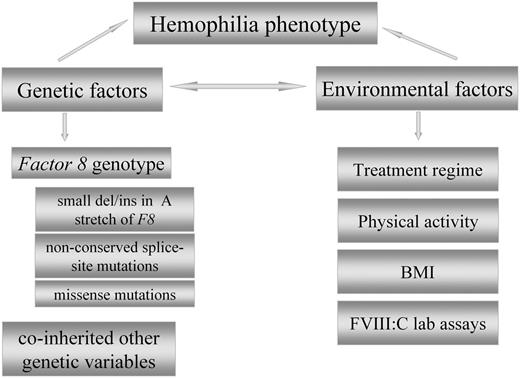Possible factors affecting the variability of hemophilia phenotype. BMI, body mass index; del/ins, deletions/insertions; FVIII:C, factor VIII activity. Adapted from Pavlova and Oldenburg.9
Possible factors affecting the variability of hemophilia phenotype. BMI, body mass index; del/ins, deletions/insertions; FVIII:C, factor VIII activity. Adapted from Pavlova and Oldenburg.9
Deficiency of blood coagulation FVIII results in hemophilia A, a serious bleeding disorder. The classification of hemophilia is based on the residual factor VIII activity; thus, the clinical presentation of the disease is primarily dependent on the severity of deficiency. In most cases, the bleeding tendency correlates well with the degree of factor deficiency. However, within the different groups of severity, considerable heterogeneity has been observed. A subset of 10% to 15% of patients with severe hemophilia A exhibit a mitigated disease phenotype, with significantly reduced frequencies of spontaneous bleeding, delay in the onset of the first bleeding and further in development of arthropathy, and lower consumption of factor concentrates.2,-4 If it is possible to predict a patient’s specific bleeding risk, individualized treatment regimens could be possible, minimizing the unnecessary burden and costs of prophylaxis in patients having a mild bleeding tendency.
Here, Carcao et al performed a detailed analysis on the correlation between phenotypic expression of severe hemophilia A and F8 mutation in 621 previously untreated patients. Since the introduction of prophylactic treatment, several parameters (bleeding frequency and concentrate consumption) characterizing the clinical phenotype of hemophilia are no longer applicable. Therefore, the authors postulate that the time from birth to the start of prophylaxis, and especially ages at first bleed and ages at first and second joint bleed, may represent the most suitable variables defining the bleeding phenotype of patients with severe hemophilia. They provide evidence that the type of F8 mutation can serve as a determinant of bleeding tendency in severe hemophilia.
Patients bearing non-null mutations exhibit a milder clinical phenotype, a later age of disease diagnosis, and a later age of the first bleed, first joint bleed, and second joint bleed compared with those with null mutations. A review of literature shows limited data, and only a few studies demonstrate that small deletions/insertions within poly-A runs of exon 14 of F8, nonconserved splice-site mutations, and some missense mutations have a mitigating effect on the bleeding phenotype (see figure).5,-7 The milder phenotype in these patients may be a result of the presence of residual amounts of endogenous FVIII activity that are undetectable with current routine FVIII activity measurement assays.
The resulting small amount of endogenous FVIII protein not only is associated with a mitigated phenotype of severe hemophilia A but also might protect against inhibitor development. Although the results of Carcao et al show statistical significance, the longest time difference between the groups of patients with null and non-null mutation is only 2.3 months for the age of first joint bleed. This finding raises the question of whether F8 mutation can affect clinical decisions such as the choice and time of onset of prophylaxis and the application of individualized dose regimens in children with severe hemophilia A. The authors demonstrate that the relatively minor differences in the ages at first bleed and ages at first and second joint bleed, ranging between 1.2 and 2.3 months within the groups with null and non-null mutation, although contributing for the milder clinical phenotype, might not significantly influence the treatment decision, at least at early childhood.
In addition, considerable interpatient phenotypic heterogeneity among patients with the same F8 mutation suggests that there are other factors than F8 mutation accounting for mitigating hemophilia phenotype.8 Although it is believed that the F8 mutations are the strongest predictor of patient’s bleeding tendency, the carefully performed investigations by Carcao et al revise the presence of other factors as genetic alterations and polymorphisms in other hemostatic genes, differences in inflammatory and immune response, and limitations in laboratory diagnostic, as well as environmental factors that alone or together could shape the individual bleeding phenotype in patients with severe hemophilia (see figure). Thus, the authors speculate that differences in the treatment regimens appear to be the largest modifier of hemophilia phenotype rather than F8 mutation or other genetic variations in coagulation.
Why some individuals with severe hemophilia bleed more than others is still poorly understood. The study of Carcao et al is a prospective one, based on a relatively high number of subjects, and spread a light in finding markers characterizing the clinical phenotype even before the first bleeding occurs. On the basis of the findings of this study, it is reasonable to assume that F8 mutation, as a genetic marker for the heterogeneity of hemophilia, most likely does not play this role alone but is, rather, a team player together with other factors in this complex process. Thus, identifying factors attenuating the bleeding phenotype in patients with hemophilia could allow us not only to predict the bleeding pattern but also to influence the treatment decisions, such as time of starting the prophylaxis, tailoring it according to bleeding pattern, and they could also suggest potential alternative targets for preventive and therapeutic intervention.
Conflict-of-interest disclosure: The author declares no competing financial interests.

